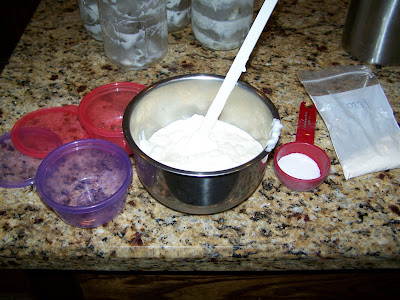I'm a Fage freak. I LOVE the stuff. It's a total treat when I can find it on sale. But even on sale, about $3 for 2 cups is a steep price to pay for yogurt.
I've been making yogurt intermittently for about a year now. It's a surprisingly easy process and requires no special equipment.
You'll need:
A large pot with a lid
A thermometer (I use a meat thermometer)
A roaster oven or cooler
Large glass bowl or glass jars, app. 5 quarts
1 gallon milk, fat percentage is up to you
1 cup plain yogurt, as fresh as possible, fat content up to you
1 Tbsp sugar
Powdered milk, enough to make 4 quarts
Begin by pouring gallon of milk in pot over medium heat.
Whisk in powdered milk and sugar. Cover. My lid has holes for straining which were ideal for putting my thermometer in.
Allow to cook until temperature reaches 180. Took me about 40 minutes. Be sure not to cook over high heat. Check it occasionally to make sure the milk isn't scorching.
Allow milk mixture to cool to 100-110 degrees. Stir in yogurt. I used Aldi brand nonfat plain yogurt.
Pour into clean jars or bowl. Use glass. I used 5 quart jars.
Cover with plastic wrap.
Now you have to incubate the yogurt. I use a roaster over like this.
If you don't have one of these, most people use a cooler. Just be sure to have a warm place to leave it. Like the garage on a warm afternoon. The same steps for adding water would apply if you use a cooler.
I add hot water to the oven and set it at the lowest estimated temperature to keep the yogurt near 100 degrees.
Place jars in the oven or cooler with hot water.
Leave it. Forget it even. To make it tart it needs to sit for more than 12 hours. You should have yogurt after 3 hours but it will likely be watery. After 12 hours it will be substantially thicker. After 15 hours I have yogurt like this.
It's hard to tell but it's solidified and the whey has risen to the top.
Now refrigerate the yogurt overnight. This is what my yogurt looks like now.
But I want Fage-like Greek yogurt. So I must strain it. So I construct this apparatus of a large bowl under a strainer.
Then I line it with paper towels. I have no cheese cloth. Wish I did.
Then I dump a jar of yogurt in.
I do the same with 3 of the remaining jars. 1 jar I save for Nathan, the other yogurt eater. He likes vanilla yogurt. I just happen to have vanilla powder from the local natural foods store. I add vanilla powder and sugar until he approves. Now we have home made vanilla yogurt!!
Back to the strained Greek yogurt.
When you strain yogurt you are removing the whey. I had this left from one jar:
My yogurt was this thick after straining for 1 day:
1 quart jar filled my saved "reused" Fage container.
The other 3 jars I let strain about 14 hours. That yogurt was a bit thicker:
So in summary, from 1 gallon of milk I yielded the following:
The left containers are of whey. The middle containers are of the Greek yogurt. The right 2 containers are the vanilla yogurt.
Why save whey? It's extremely nutrient dense having a high percentage of calcium. Check out the nutrition facts for whey here. Here are some uses:
-proof yeast in bread recipes or use in place of milk or other liquids
-use as liquid in soups, stews, pasta, boiling potatoes
-use in smoothies, milkshakes
-use in salad dressings
So, is it worth it? Let's look at my cost out of pocket.
Milk: $1.59
pwdr milk: 4.24*
Sugar: n/a
Yogurt: .99
Total $6.82
Yield 10 cups
plus whey
10 cups of Fage? If on sale at $3 per container to get 10 cups worth I'd have to buy 5 containers. So it'd cost me at least $15, more than twice as much.
Time invested: 3 days :(
So, if you are interested enough to try it I think the cost savings is definitely worth it. I promise, you'll NEVER get yogurt that tastes this good in the store. It's as fresh as you can possibly get. And once you make some, just save a bit for your next batch and you don't need to buy any ever again. Plus, the total time spent actively "doing" something is nominal. Mostly it's just pouring from one container to another.
Let me know if you decide to try it and how it works out!!





















No comments:
Post a Comment